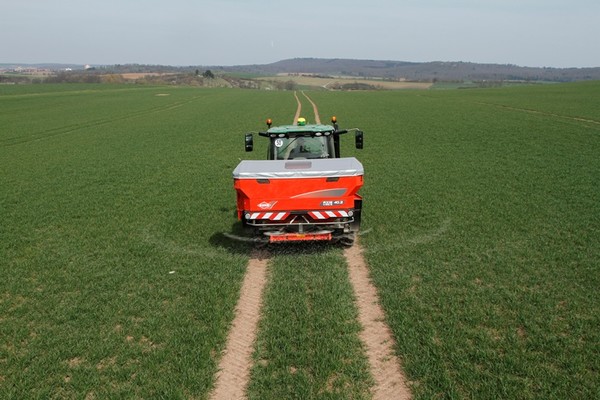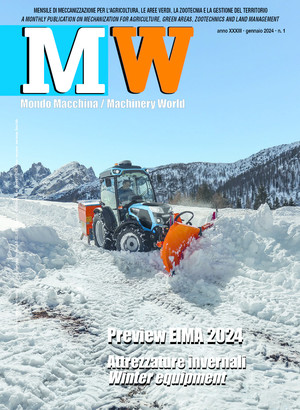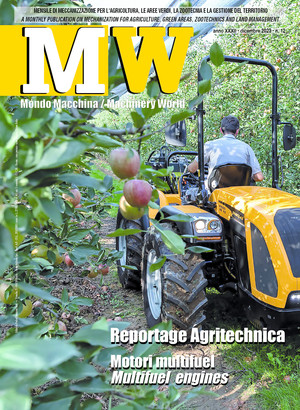
Optimize the processing: mineral fertilizer spreaders
The variable-rate fertilizer spreader is usually characterized by the presence of different devices: independent dose adjustment for each delivery disk. The system, usually defined as EMC (Electronic Mass flow Control), is based on the continuous correction of the position of the metering valve in relation the rotation torque generated on each disk, detected by dedicated electronic sensors. In this way, it is possible to continuously adjust the dose to be distributed. This is followed by the control of the opening of the nozzles, for the distribution on the basis of the data obtained through the sensors. Such a solution allows working without risk of clogging, or problems of inhomogeneity and/or operation on sloping ground, with a constantly controlled flow aimed at the best adherence to the desired dose, in terms of transverse distribution, with the appropriate overlaps of a diagram which, in theory, it is typically of triangular conformation. A further (economic and environmental) advantage concerns the possibility of operation of the spreader with a low engine speed of the tractor, with consequently reduced fuel consumption; the working width is variable and can be adjusted directly from the tractor driver's seat through an electronic control system allowing to change the granulate drop point on the rotating disk, so as to allow, for example, the partial distribution, or the distribution on the borders without unnecessary dispersion of the product; the georeferenced control system of the position through GPS, which integrates the optimization of the valves opening and closing for the spreading of any type of the granulate (each with its own characteristics and dimensions that are readily recognized by the electronic control system), checking the dosage and the work in the open field or on the edges and the distance between one passage and the other; the forward proportional distribution system (DPA) mode, which allows the dose to be kept appropriately, compensating to the fullest the inevitable changes of the speed rate. This objective is achieved thanks to the adjustment of the fertilizer exit lights, or of the point of fall of the latter on the light, which changes according to the rate speed. This is a condition that commonly occurs during processing, especially at the beginning and end of the field, or in case unexpected obstacles are encountered along the field; electronic weighing, carried out with strain gauge load cells, continuously monitoring the amount of material still in the hopper and therefore, for the difference, the one already distributed. The obvious advantage is being able to instantaneously know the residual autonomy of the single load of the machine, so as to be able to program the hopper charge with maximum efficiency.
Equipment for VRT operation
The variable-rate fertilizer spreader is usually characterized by the presence of different devices: independent dose adjustment for each delivery disk. The system, usually defined as EMC (Electronic Mass flow Control), is based on the continuous correction of the position of the metering valve in relation the rotation torque generated on each disk, detected by dedicated electronic sensors. In this way, it is possible to continuously adjust the dose to be distributed. This is followed by the control of the opening of the nozzles, for the distribution on the basis of the data obtained through the sensors. Such a solution allows working without risk of clogging, or problems of inhomogeneity and/or operation on sloping ground, with a constantly controlled flow aimed at the best adherence to the desired dose, in terms of transverse distribution, with the appropriate overlaps of a diagram which, in theory, it is typically of triangular conformation. A further (economic and environmental) advantage concerns the possibility of operation of the spreader with a low engine speed of the tractor, with consequently reduced fuel consumption; the working width is variable and can be adjusted directly from the tractor driver's seat through an electronic control system allowing to change the granulate drop point on the rotating disk, so as to allow, for example, the partial distribution, or the distribution on the borders without unnecessary dispersion of the product; the georeferenced control system of the position through GPS, which integrates the optimization of the valves opening and closing for the spreading of any type of the granulate (each with its own characteristics and dimensions that are readily recognized by the electronic control system), checking the dosage and the work in the open field or on the edges and the distance between one passage and the other; the forward proportional distribution system (DPA) mode, which allows the dose to be kept appropriately, compensating to the fullest the inevitable changes of the speed rate. This objective is achieved thanks to the adjustment of the fertilizer exit lights, or of the point of fall of the latter on the light, which changes according to the rate speed. This is a condition that commonly occurs during processing, especially at the beginning and end of the field, or in case unexpected obstacles are encountered along the field; electronic weighing, carried out with strain gauge load cells, continuously monitoring the amount of material still in the hopper and therefore, for the difference, the one already distributed. The obvious advantage is being able to instantaneously know the residual autonomy of the single load of the machine, so as to be able to program the hopper charge with maximum efficiency.
The benefits of new fertilizerspreaders
The variable-rate fertilizer spreaders are referred to as the future of mineral fertilization because they are able to provide different advantages compared to traditional methods.
The cost is certainly higher than the conventional models, but convenience, especially in the case of a long useful life, and a rather frequent use, on balance sheet results to be significant also for medium-small companies.
From the environmental point of view, being able to regulate the total amount of fertilizer distributed according to actual needs, as well as the possibility to dose the flow on each disk, according to the agronomic characteristics of the field and the shape of the plot, allows avoiding waste and overdoses.
Among other things, the potential environmental risk of the distribution on the edges notably increases in the presence of adjacent watercourses.
The purchase by the farmer of the correct amount of fertilizer also leads to further advantages in terms of management as far as the storage and conservation phase is concerned, but more directly in being able to keep under control the most correct development, and the health status of the crop, so as to intervene as soon as possible if further interventions are necessary, on specific areas of the single plot.








